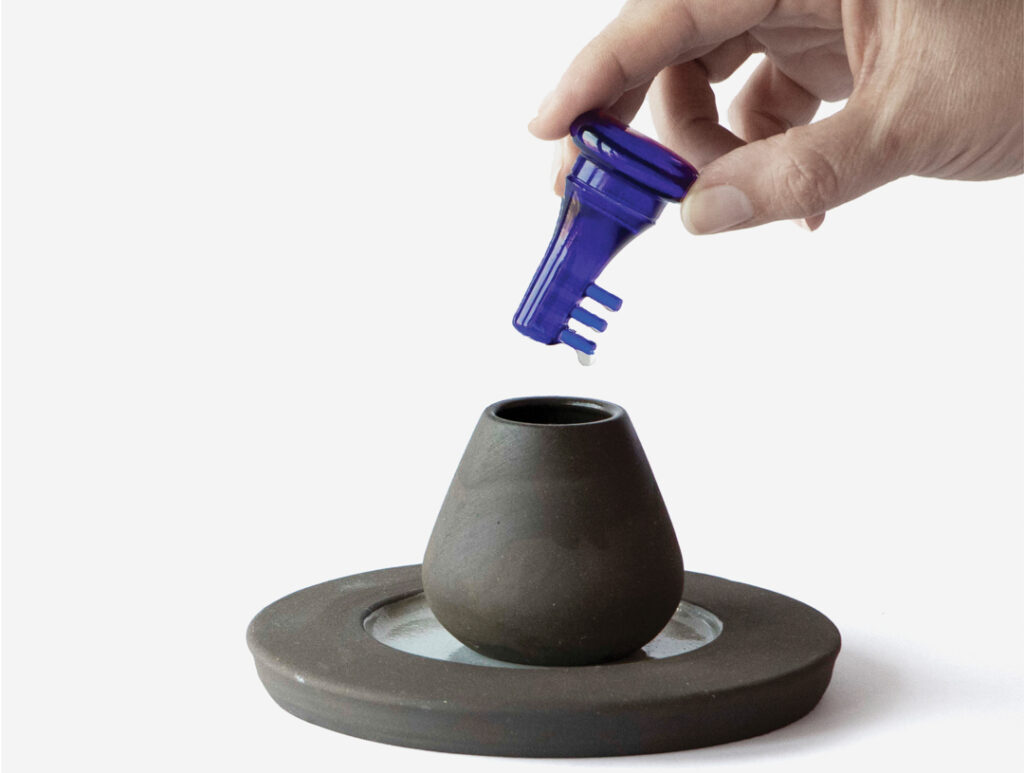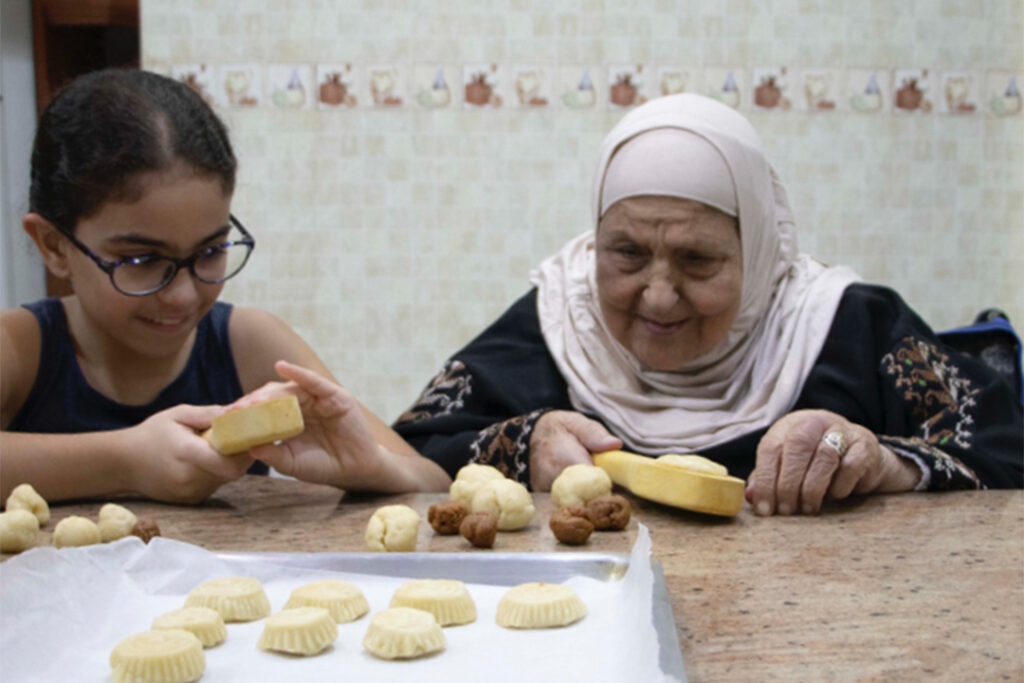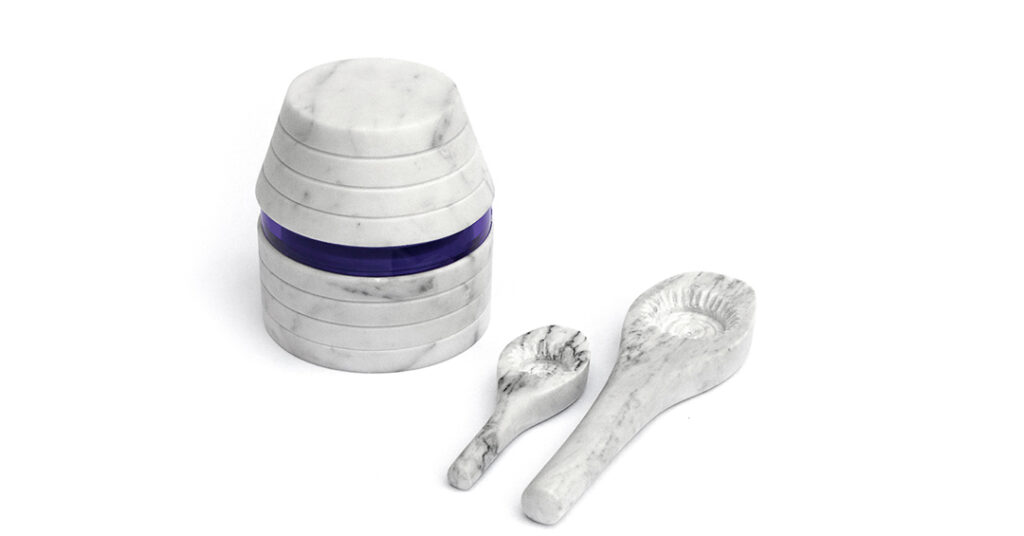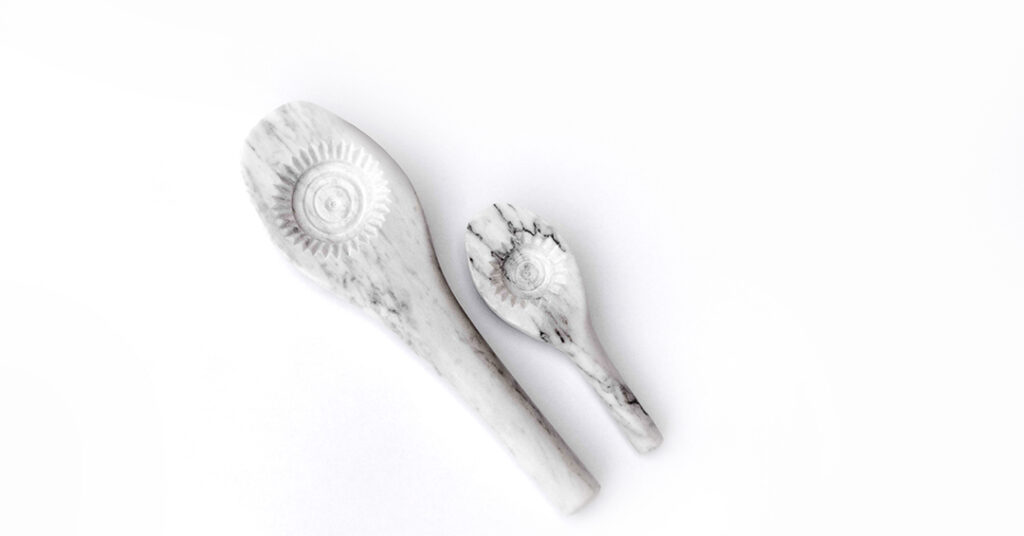Reema Abu Hassan has designed receptacles for the olfactory memories that are so precious to the Palestinians dispersed across the world.
(A message to the reader.)
In the home where my Palestinian grandmother has lived for the last 37 years, tools and ingredients—purchased from local shops in Qatar—cover the kitchen counter-top. Every year my grandmother and I gather around the counter-top and set up our annual Eid ritual. This ritual was born in the diaspora, following the 1948 catastrophic rupture, which exiled my grandmother from her home in Palestine. She has performed this ritual for decades and keeps it alive by teaching it to me, and to her other granddaughters.
To participate in this ritual, we gather during the month of Ramadan, just a few days before Eid. We perform the choreographed steps of making maamoul, the dough and date treat we associate with Eid. As we press the dough into the maamoul molds and begin to bake, a wonderful aroma fills the house and draws together four generations of exiled family members, who gather to celebrate and taste the maamoul. When this ritual takes place, Palestine’s existence becomes more tangible, and the entire family is connected to their individual and collective Palestinian identities. Once it passes, the Palestinian-ness of our diasporic family recedes into the background of everyday life. The tools are put away until the ritual repeats and they are taken out again the following Eid.
Rituals such as this maamoul making are important to us as displaced Palestinians in order to remain connected to our lost homeland. Despite the importance of memory for us, and our history of suffering and exile, there have not been any significant monuments designed to preserve our collective memory.
A monument is traditionally static and monumentalizes a single narrative of a place and an event to preserve a collective memory. However, Palestinian collective memory is not static; it is everchanging, due to the plurality of personal Palestinian experiences and memories that reject a single narrative. For displaced Palestinians, connections to Palestine are weakened with every passing generation, which threatens the erasure of Palestinian-ness.
In an effort to preserve my family’s Palestinian-ness, I designed handcrafted objects that consider the adaptation of a traditional monument by redesigning it to the specificity of the Palestinian diaspora. In doing so it proposes the monumentalizing of four Palestinian rituals to add significance, meaning and permanence to them. The four rituals are making maamoul, applying orange and mashmoom perfume oil to hair, pouring Palestinian olive oil and dispersing sage tea leaves within a family. The key attributes captured, conveyed and explored within these rituals are the role of the matriarch and the sensory olfactory system that elicits memories and narratives of Palestine.
Remembering Home
- Reema, Remembering Home, 2020, Marble and Blue Glass
- Reema, Remembering Home, 2020, Marble and Blue Glass,
- Reema, Remembering Home, 2020, Marble and Blue Glass,
The first set of objects monumentalizes the maamoul making ritual. My grandmother prepares all of the ingredients, including her signature spice, which gives the maamoul its flavour and scent. She stores the spices in a generic plastic container with a ripped piece of paper for a label. Once the maamoul is baked, the scent of the spice fills the house and draws my entire family together. When this ritual is performed, Palestine exists for my multi-generational family. Despite the importance of this ritual, the tools used lack specificity and value. The only specific tools that we have are the invaluable wooden molds used for pressing the dough into its distinctive maamoul form.
To monumentalize this important ritual, I designed new maamoul molds, made from Carrera Marble. My grandmother’s hand is her unit of measurement. The size of the large mold corresponds to the size of her hand. A scaled-down mold is designed to fit the hand of her six-year-old granddaughter, who is being taught to use her own hand as a unit of measurement. The pair of molds—one large and one small—facilitate my grandmother’s need to pass this Palestinian ritual on to future generations, to instill a sense of Palestinian identity in us.
To accompany the molds, I also designed a spice jar. Like family members reuniting at Eid, it is made from interlocking rings, each layer dependent on the others. The rings recall the pattern of concentric rings, within the mold, which form the distinctive pattern of maamoul.
The designed artifacts reference the materiality of traditional monuments. Marble is historically used for monuments due to its endurance, precision, luxuriousness and ability to elevate the content of the monument itself. Likewise, the two molds and the spice jar are made from Carrera Marble to monumentalize my grandmother’s ritual. The durability of the material allows the tools to be passed down to future generations, ensuring the endurance of her Palestinian ritual and legacy.
Hybridizing Scents of Home
In a diaspora, there is an inherent hybridization formed between the culture of the homeland and the host country, where displaced people spend their lives. My family has spent most of their lives in Qatar and have inevitably acquired some Qatari cultural traits, which have become a part of their own identity. This second set of objects celebrates this fusion of Palestinian and Qatari culture.
Mashmoom is an indigenous plant in Qatar, traditionally used to produce a perfume oil, which Qatari women apply to their hair. It is popular with young Qatari women, who associate its scent with fond memories of family matriarchs.
In my family of Palestinians exiled from Jaffa, we have inherited our grandmother’s memory of the scent of oranges. When I smell oranges, the scent elicits my grandmother’s stories of Jaffa and the connection it held, for her, with Palestine.
Combining these two narratives—of my grandmother’s fondness for the scent of oranges and a Qatari grandmother’s ritual use of mashmoom oil, I designed a ceramic vessel to contain the combined scents of mashmoom and oranges. The ceramic is slightly porous—by design—and a small amount of oil seeps through, allowing the scent to emanate. The patina that builds up over time, as the oil slowly seeps, is a metaphor for the luster of inherited affinity.
Similar to the form of the maamoul spice jar, the formal qualities of the perfume bottle draw from traditional monuments. Like a temple on a stone plinth, the perfume bottle sits, securely elevated, on a matching ceramic dish, which is designed to collect the precious oil, as it seeps through the porous ceramic container. A blue glass comb plugs into the top of the bottle. The comb is used to apply a few drops of oil to the hair. The resulting project monumentalizes the ritual application of scented oil, which carries the scents of two fused cultural traditions.
- Reema, Hybridizing Scents of Home, 2020, Blue Glass and Black Stoneware,
- Reema, Hybridizing Scents of Home, 2020, Blue Glass and Black Stoneware,
Funneling Resistance
Olive oil is a powerful symbol of Palestine, found in homes and institutions throughout the Palestinian diaspora. It is associated with Palestinian identity, politics, suffering and Israeli occupation. The oil provides a direct link to a stolen and lost home. Palestinian olive oil is often imported by families in the diaspora in large tin containers. My grandmother imports these tins and stores them out of sight, in a dark cupboard. She brings them out only long enough to pour the oil from the tins into smaller containers, for daily use, using a plastic funnel. From there, she pours the oil into an even smaller container, which sits on her dresser. She keeps it handy so she can massage olive oil into her joints, to alleviate pain. It is a ritual she inherited from her mother but adapted to her current situation in the diaspora. Being away from her homeland, she must now import large quantities of olive oil.
To memorialize my grandmother’s ritual of pouring out the Palestinian olive oil, I designed a set of three vessels. The vessel bodies are made of clear glass to showcase the oil’s clarity—a key indicator of quality. The central blue glass piece is a dual-facing funnel. With each vessel, the funnel facilitates the pouring of oil from the tin container, or a larger size vessel, into a smaller one. The blue glass funnel can also be flipped, to form a nozzle, used to pour oil out from each vessel. The largest vessel is for storing oil, the medium size is for cooking, and the smallest is for the bedroom. Once all three vessels are filled, the funnels are capped with a clear glass top.
- Reema, Funneling Resistance, 2020, Glass
- Reema, Funneling Resistance, 2020, Glass
Sharing Scent
Sage tea is enjoyed in most Palestinian homes and is prepared for individuals, but more commonly for gatherings with family and guests. The Palestinian leaves have to be imported to Qatar and have more value and meaning in the context of the diaspora because they come from “home.”
The closest my grandmother can get to Palestine is Jordan. She visits Jordan every summer and brings back large quantities of fresh sage leaves. She dries the leaves in her kitchen as soon as she arrives at her home in Qatar. As it dries, the scent of sage fills her entire house. Her children stop by her sage-scented home to welcome her back and to receive their annual share of the dried sage. She packs the individual portions in ordinary plastic bags, for her children to take home. She stores the remainder in old cotton pillowcases, repurposed to keep the sage fresh throughout the year.
Celebrating the metaphoric resonance between the dispersal of sage leaves, and the displacement of Palestinians throughout the diaspora, I designed a new set of sacks to replace my grandmother’s pillowcase and plastic bags. The new sacks are made from tailored linen, to provide increased breathability as well as a level of transparency. The largest sack in the set is for my grandmother, and the smaller ones are for her children. The shape of the sack, inspired by the pure form of an obelisk, is designed with a circular base. This base allows the linen sack to retain its shape and structure—unlike the pillowcase— as the leaves continue to be removed. The bag is tied by gathering the fabric and looping it through a blue glass ring, which is then secured by pushing a blue glass rod through the gathered fabric, secured against the ring.
Opening the bag is now a ritualistic act. My grandmother slides the rod from the ring, and unties the linen, releasing the scent. My grandmother uses her hand to scoop up the sage, and the subtle scent lingers on her hands afterward. She transfers sage leaves into the sacks her children bring with them, when they visit. The ritualized dispersal and sharing of sage leaves occurs annually.
All of the objects are crafted by artisans and are designed to be handed down from generation to generation. They are a new type of monument, which have been adapted to the conditions of the Palestinian diaspora. The objective is to monumentalize rituals that Palestinian families have developed—throughout the diaspora, worldwide—which help them cherish and maintain connections to their ancestral homeland.
These acts of monumentalization celebrate the unique plurality of everyday life for a people who are urgently working to preserve their Palestinian memories and rituals. Monumentalized rituals connect Palestinians to their Palestinian identities, reinforcing regular activities designed to resist the erasure of Palestine by the Israeli occupation.
Inspired by four unique stories, each of the four projects celebrates the memory-triggering power of scent, the shared comfort of inherited ritual, and the singular magnetism of the family matriarch.
About Reema Abu Hassan
 Reema Abu Hassan is a designer, professor, architect, ceramic artisan and entrepreneur based in Qatar. She is the founding director of the Clay Encounters ceramic design studio. Drawing from her background in architecture, digital fabrication, theory, design and ceramics, she has developed a hybridity to her work that fosters the power of interdisciplinarity. Through Clay Encounters and her teaching position at VCU-Qatar, she has positioned design, craft, collaboration, participation and teaching as core components to the way in which she practices and conducts her research. Her current work integrates digital tools into the analogue processes of traditional modes of making within crafts and specifically within ceramics. Follow @reema_abuhassan
Reema Abu Hassan is a designer, professor, architect, ceramic artisan and entrepreneur based in Qatar. She is the founding director of the Clay Encounters ceramic design studio. Drawing from her background in architecture, digital fabrication, theory, design and ceramics, she has developed a hybridity to her work that fosters the power of interdisciplinarity. Through Clay Encounters and her teaching position at VCU-Qatar, she has positioned design, craft, collaboration, participation and teaching as core components to the way in which she practices and conducts her research. Her current work integrates digital tools into the analogue processes of traditional modes of making within crafts and specifically within ceramics. Follow @reema_abuhassan











